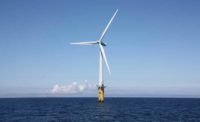Three miles southeast of Block Island, R.I., the nation’s first offshore wind farm has emerged after months of hard work by dozens of contractors, including a small team of highly skilled commercial divers.
In the final construction phase of the $300-million, 30-MW project, Norway-based Fred Olsen Windcarrier’s Brave Tern and two Montco lift boats installed the five 260-ft-long turbines, bolting the last 241-ft blade into place in mid-August.
GE technicians now are commissioning the wind turbines, and the wind farm is scheduled to begin generating electricity for Block Island by November.
Eight years in development, this small-scale project represents a huge milestone for the nascent U.S. offshore wind industry, which now has nearly two dozen projects in development. Awarded by the U.S. Dept. of Interior, 11 of those projects could support 14.6 GW of capacity, according to the National Offshore Wind Strategy report, released in September by the DOI and U.S. Dept. of Energy.
Unlike a construction worker on a dry building jobsite, a diving constructor works alone underwater, with a helmet-mounted camera and a radio for communication with a topsides supervisor.
In July, after erecting a tower gantry on the cable-lay vessel Big Max, the team began laying cable. “We started laying 30 miles of 7-inch-diameter submarine cable off the Big Max,” said Clay Horschel, Specialty Diving Services (SDS) superintendent, calling the work “the most dangerous thing you’d ever do in rough seas.”
At a depth of 125 ft, a jet sled operating 6 ft below the seabed blasted material to create trenches. There, the divers, with only about 1 ft of visibility and working in 15-minute diving rotations, conducted laying operation and maintenance, welding to change out jet nozzles.
“It was a big effort to get the welding done because the jet sled couldn’t come back up,” Horschel recalled.
Then, over seven weeks, five divers installed two hundred 8-ft by 20-ft 12,000-lb concrete mats, which protect the cable. Once the cable-laying vessel’s crane lowers the mats hooked up to a picking frame, one diver radios to say exactly where it should be positioned. After it reaches a depth 5 ft above the ocean floor, the diver sets its final location.
For the first week, the team tried to set the mats. "Some days went flat out well, but when the seas picked up, the divers couldn't see anything," Horshel said.
SDS diver Tom Dupre remembered his trepidation while trying to set the mat. It “was really bouncing around. I tried to stay on top to guide it, not wanting to get [crushed] under it.” Another SDS diver, Ryan Nulph, said he fought off five sharks that were attracted to his dive light.
After concluding that working from the Big Max was unproductive, the Deepwater team moved from the Big Max out to the 75-ft-wide by 129-ft-long Michael Eymond jack-up barge, close to the construction site where they had a more stable platform for the crane and better underwater visibility. Four divers slept in one 12-ft by 8-ft room on the barge.
“Just to lay the power cable and set the mats required over 250 dives, not including earlier inspection work on the turbine foundations and installation of the [spar] test buoy and its mooring,” Horschel says.
Despite the obstacles, work came in on budget and a few days ahead of schedule, according to Deepwater Wind, the Providence-based developer.






Post a comment to this article
Report Abusive Comment